Absorption of Oral Coenzyme Q10 Varies Considerably
The Two Redox Forms of Coenzyme Q10
In the accompanying video, we show that Coenzyme Q10 supplements come in two redox forms: ubiquinone and ubiquinol. The ubiquinone form is the oxidized form, the form that is an electron acceptor. The ubiquinol form is the reduced form, the form that is an electron donor. In the human body, the Coenzyme Q10 molecules convert back and forth from the oxidized form to the reduced form and back again numerous times, taking on and giving off electrons according to what the body's chemistry needs.
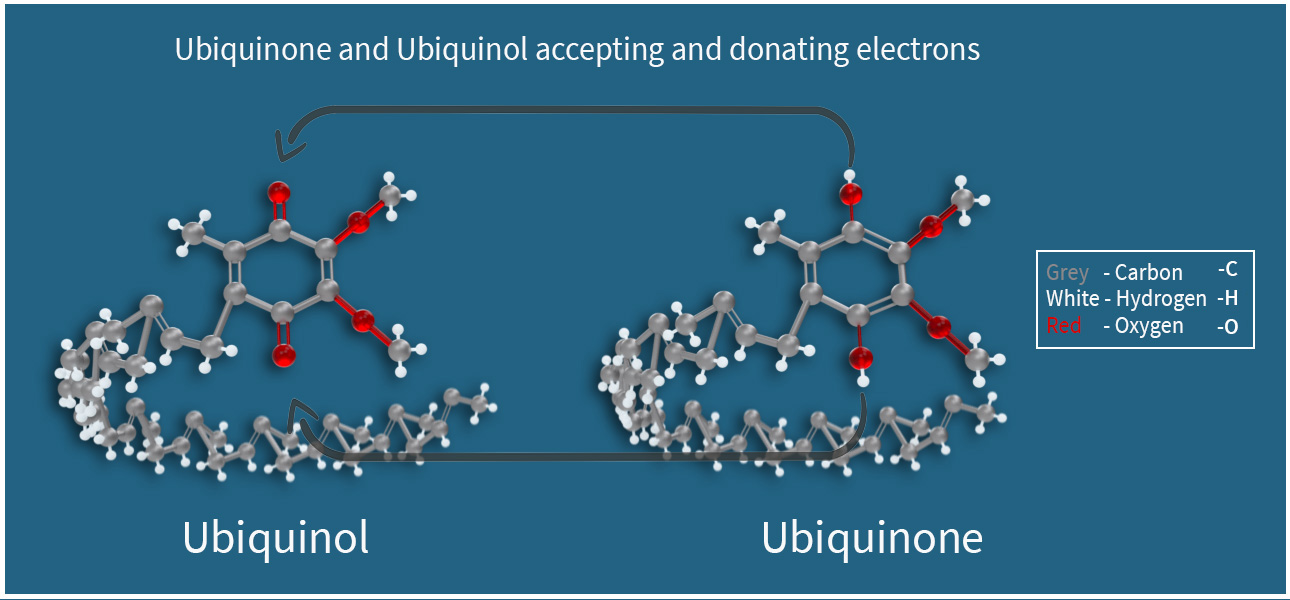
Fig. 1 Coenzyme Q10 molecules are redox molecules. The oxidized form, ubiquinone, is ready to accept electrons. The reduced form, ubiquinol, is ready to donate electrons.
CoQ10 supplements are not equally well absorbed. There is much variation in the absorption of different ubiquinone formulations and in the absorption of different ubiquinol formulations and also much variation in the absorption between the two forms of Coenzyme Q10 (Judy 2018). The ubiquinone CoQ10 supplements tend to be less expensive, more stable, and better documented than the ubiquinol supplements. The important thing is to buy a CoQ10 supplement for which there is published scientific evidence of both absorption and efficacy.
The Importance of Coenzyme Q10 Absorption
In normal healthy adult individuals, the expected unsupplemented plasma CoQ10 concentration is approximately 0.8 +/- 0.2 micrograms per milliliter (Langsjoen 2014). Factors such as age, cholesterol level, disease, exercise regimen, gender, muscle mass, and race can change the plasma CoQ10 concentration such that the normal range can extend from 0.5 to 1.9 micrograms per milliliter (Miles 2003).
Supplementation is needed to raise plasma CoQ10 concentrations to the 2.5 micrograms per milliliter level necessary for adjuvant therapeutic use for heart disease (Langsjoen 2014) and to the level of 3.5 micrograms per milliliter needed in the treatment of neurodegenerative diseases (Langsjoen 2014).
Once we humans reach adulthood, our bio-synthesis of Coenzyme Q10 decreases with increasing age. It is practically impossible to make up for the decrease in endogenous CoQ10 synthesis by eating more food or by eating CoQ10-rich foods. Because endogenous bio-synthesis is our primary source of Coenzyme Q10, supplementation is a must as we grow older (Hargreaves & Mantle 2019).
Dosage of Coenzyme Q10 Supplementation
Both dosage and duration are important factors in the uptake of the oral Coenzyme Q10 from supplements, especially for uptake in the heart and the brain (Bhagavan & Chopra 2006).
Daily dosages of 100 to 300 milligrams are typical for heart disease patients (Mortensen 2014). Daily doses of 600 to 1200 milligrams have been used in the treatment of neurodegenerative diseases (Bhagavan & Chopra 2006).
CoQ10 supplementation in either form – ubiquinone or ubiquinol – is safe and well-tolerated. The observed safe upper level of Coenzyme Q10 intake for adults is 1200 milligrams per day (Hathcock 2008). Adverse effects from Coenzyme Q10 supplementation – typically, nausea or minor gastrointestinal discomfort – seldom occur at a higher rate than adverse effects from placebo supplements do. The number of such adverse effects has been no higher at 1200 milligrams per day than at 60 milligrams per day (Hathcock 2008).
Absorption of Coenzyme Q10 Difficult Regardless of the Form
The Coenzyme Q10 raw material comes in a crystalline form. The body cannot absorb CoQ10 crystals; the crystals must be dissolved to single CoQ10 molecules at body temperature for absorption to be possible (Judy 2018).
The success or failure of the absorption of Coenzyme Q10 molecules depends in great part upon the specific oils the CoQ10 capsule manufacturer attempts to dissolve the CoQ10 raw material in and depends upon the resultant solubilization of the CoQ10 in the oil matrix. The oils in the oil matrix are important both for the dissolution of the CoQ10 crystals and for serving as carrier molecules for the CoQ10 molecules in the small intestines. In some cases, the inclusion of certain excipients may inhibit absorption of the Coenzyme Q10, e.g. too much vitamin C in a ubiquinol supplement or simultaneous intake of too much vitamin E (Lopez-Lluch 2019).
.jpg)
Fig. 2 The Coenzyme Q10 raw material is difficult to dissolve to make it absorbable. Different manufacturing formulations using different carrier oils and different heating and cooling processes will result in different absorption and bio-availability rates.
The Form and Structure of the CoQ10 Crystals
Under the microscope, CoQ10 crystals in an oil matrix appear in three basic forms: lumpy crystals, plate-like crystals, and needle-shaped crystals. The better the CoQ10 crystals are able to dissolve to single CoQ10 molecules, the better the absorption will be.
At body temperature, a temperature that is far below the melting point of the CoQ10 crystals, the lumpy crystals and plate-like crystals will yield many fewer single CoQ10 molecules than the needle-shaped crystals will.
The undissolved CoQ10 crystals will mostly be eliminated without giving off very many single CoQ10 molecules to be absorbed.
The patented process that Pharma Nord uses in the manufacturing of Myoqinon and Bio-Quinone capsules is based on a specific composition of the oil matrix and based on a special heating and cooling process prior to encapsulation of the oil matrix containing the Coenzyme Q10. This patented process results in the formation of more easily dissolvable needleshaped CoQ10 crystals with a large surface area-to-volume ratio. These crystals will dissolve more at body temperature to free single Q10 molecules that the intestinal cells can absorb
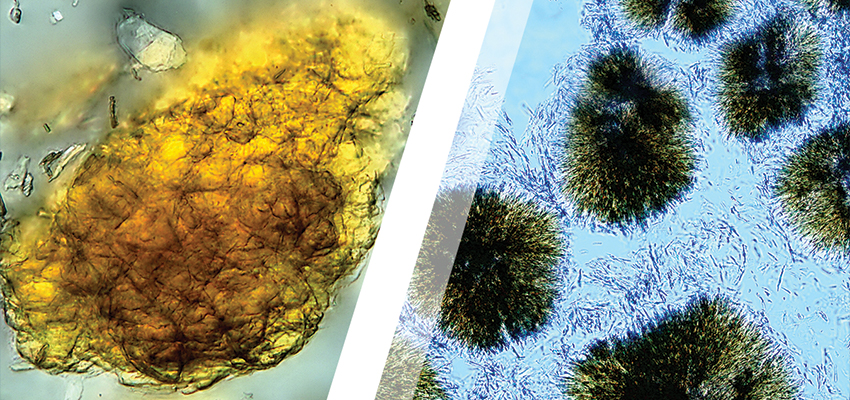
Fig. 3 Microscope picture of plate-shaped and lumpy CoQ10 crystals (left) and needle-shaped (snowflake-shaped) CoQ10 crystals (right)
Other manufacturing processes result in the formation of lumpy CoQ10 crystals that do not dissolve nearly as well to single free molecules and thus get eliminated instead of absorbed.
Simple Passive Facilitated Diffusion for Absorption of Coenzyme Q10
Coenzyme Q10 molecules are large molecules with a molecular weight of 864 Daltons for the ubiquinone molecules and 866 Daltons for the ubiquinol molecules, too large to be absorbed directly into the capillary network and then into the blood. The CoQ10 molecules are fat-soluble molecules. Being the large fat-soluble molecules that they are, CoQ10 molecules are absorbed by a process of “simple passive facilitated diffusion” through the phospholipid intestinal absorption cell membranes (Judy 2018).
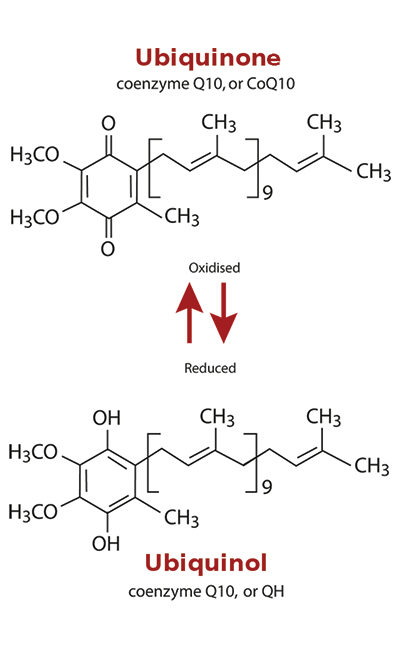 Fig. 4 Picture of Coenzyme Q10 molecules with benzoquinone head and 10 isoprenyl sub-units in the tail (all sub-units in the tail not depicted here).
Fig. 4 Picture of Coenzyme Q10 molecules with benzoquinone head and 10 isoprenyl sub-units in the tail (all sub-units in the tail not depicted here).
“Passive” means that there is no active energy-driven transport agent to take the CoQ10 molecules through the small intestines to the intestinal absorption cells. “Facilitated” means that the absorption of the CoQ10 molecules requires the assistance of a carrier lipid, typically a monoglyceride. The “diffusion” process itself depends upon having a greater concentration of the CoQ10 in the watery phase of the small intestines than there is in the intestinal absorption cells (Judy 2018).
Bio-Synthesis of Coenzyme Q10 Reduced by Ageing and Statin Medications
Supplementation is necessary to achieve greater concentration of CoQ10 because the ageing process, the use of certain medicines such as the statin medications, and the development of some diseases will cause a reduction in the body's bio-synthesis of Coenzyme Q10. It is practically impossible to make up the loss of Coenzyme Q10 by eating more or by eating more wisely (Judy 2018).
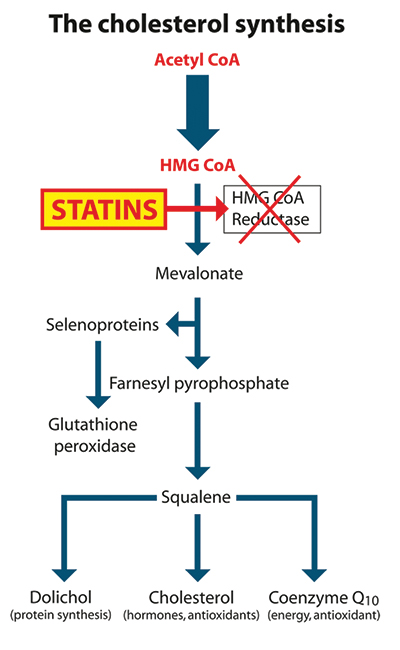 Fig. 5 The statin medication interferes with the mevalonate pathway, inhibiting not only the synthesis of cholesterol but also of Coenzyme Q10.
Fig. 5 The statin medication interferes with the mevalonate pathway, inhibiting not only the synthesis of cholesterol but also of Coenzyme Q10.
Coenzyme Q10 Molecules Fat-Soluble and Absorbed as Fat-Soluble
Attempts to make the CoQ10 molecules water-soluble (also called hydrophilic or hydro-soluble) involve the use of surfactants to make the molecules more dispersible in water or involve the changing of the structure of the molecules. Neither approach seems to work well. In the first instance, the CoQ10 molecules remain fat-soluble and must be absorbed as fat-soluble molecules. In the second instance, the structure is altered, and the molecules are no longer CoQ10 molecules (Judy 2018).
Studies have shown that the absorption of Coenzyme Q10 will be improved if the supplement is taken together with a meal that contains some fat. Other studies have shown that split daily doses give a greater absorption than single doses; accordingly, a divided dose of two times 100 milligrams, both with meals, will result in better absorption than a single 200-milligram dose taken with a meal (Singh 2005).
Both Redox Forms of Coenzyme Q10 are Important
It makes no sense to say that ubiquinol is more important than ubiquinone or that the ubiquinol form is a more active form of Coenzyme Q10 than the ubiquinone form (or to say the opposite).
In the electron transport chain, in the series of complexes that facilitate the body's synthesis of ATP (adenosine triphosphate) chemical energy molecules, the Coenzyme Q10 molecules need to be in the oxidized form, the ubiquinone form, in order to be reduced (to take on electrons) by Complex I or II to ubiquinol. Then, the resulting reduced Coenzyme Q10 (the ubiquinol form) will be re-oxidized by Complex III to ubiquinone.
.png)
Fig. 6 The Electron Transport Chain in the cells’ mitochondria can be compared to a conveyor belt in a factory that produces the energy substance ATP. In this chain, Coenzyme Q10 plays a critical role, acting as an electron-transfer carrier. Without adequate Coenzyme Q10, the “conveyor belt” and thus the ATP energy production will not work optimally.
In this way, the Coenzyme Q10 molecules act cyclically, shuttling back and forth from the oxidized form to the reduced form and back again continuously in reactions that are called redox reactions. Our bodies need this conversion back and forth of the oxidized and reduced forms of Coenzyme Q10.
Bio-Energetic Property of Coenzyme Q10
For the purpose of cellular bio-energetics, which is the bio-medical term for the transformation of the energy stored in nutrients to the chemical energy of ATP, the ubiquinone form of CoQ10 is essential. The process cannot start without it. In the inner membrane of the mitochondria in the cells where energy is produced, the CoQ10 is much needed in the form of ubiquinone.
.jpg) Fig. 7 In the cells and tissues, Coenzyme Q10 is found primarily in the mitochondria, the doublemembrane covered organelles found in most human cells (but not in red blood cells). For the most part, the mitochondria are known as the powerhouses of the cells. In the mitochondria, electrons from fatty acids and sugars are used to generate ATP energy molecules in a process that requires the availability of the ubiquinone form of Coenzyme Q10.
Fig. 7 In the cells and tissues, Coenzyme Q10 is found primarily in the mitochondria, the doublemembrane covered organelles found in most human cells (but not in red blood cells). For the most part, the mitochondria are known as the powerhouses of the cells. In the mitochondria, electrons from fatty acids and sugars are used to generate ATP energy molecules in a process that requires the availability of the ubiquinone form of Coenzyme Q10.
Antioxidant Property of Coenzyme Q10
For the purpose of antioxidant protection, the cells need the reduced form of CoQ10. The ubiquinol form is the form that donates electrons to neutralize harmful free radicals that otherwise would steal electrons in destructive chain reactions. CoQ10 molecules in their reduced form can give up electrons without being damaged themselves.
The donating of electrons by the ubiquinol form of CoQ10 causes no harm to the Coenzyme Q10 molecules because the Coenzyme Q10 molecules are then stable in their oxidized form, ubiquinone. Indeed, the resulting oxidized CoQ10 (ubiquinone) molecules are necessary and useful for the bioenergetics of the cells. By donating electrons to neutralize free radicals, the ubiquinol molecules prevent free radical damage to cells, proteins, fatty acids, and DNA.
.png) Fig. 8 Coenzyme Q10 in its reduced form, ubiquinol, acts as an antioxidant, donating two electrons to quench free radical reactions. Donating two electrons does not harm the Coenzyme Q10 molecule; instead, it reverts to the more stable oxidized form, ubiquinone.
Fig. 8 Coenzyme Q10 in its reduced form, ubiquinol, acts as an antioxidant, donating two electrons to quench free radical reactions. Donating two electrons does not harm the Coenzyme Q10 molecule; instead, it reverts to the more stable oxidized form, ubiquinone.
Ubiquinone Form of Coenzyme Q10 More Stable
Just to be clear, the ubiquinone form of Coenzyme Q10 is the form that the human body itself synthesizes. The ubiquinone form of CoQ10 is the more stable form of Coenzyme Q10 for the manufacturers of CoQ10 capsules to use. The ubiquinol form of CoQ10 is, by comparison, an unstable form. It is unstable by the very nature of its being an antioxidant: it is constantly looking to donate electrons and change its form to the oxidized form, the ubiquinone form.
.jpg)
Fig. 9 The ubiquinone raw material and the ubiquinone capsule contents should appear yelloworange in color. The ubiquinol raw material and the ubiquinol capsule contents should appear milky-white. If the contents of a ubiquinol capsule appear to be yellow or orange, that could be a sign that the ubiquinol contents have begun to oxidize to the ubiquinone form of Coenzyme Q10 already inside the capsule.
As to the form of Coenzyme Q10 in the food we eat, a study of the CoQ10 content in 70 different foods common to the Japanese diet has shown that approximately 54% of the CoQ10 contained in the foodstuffs is in the ubiquinone form (Kubo 2008).
Myths and Misconceptions about the Absorption of Coenzyme Q10
There are many myths and misconceptions about which form of CoQ10 supplement is better absorbed. Based on available evidence, it is mistaken to claim that the ubiquinol form of Coenzyme Q10 is always better absorbed than the ubiquinone form. Actually, the best evidence shows that the formulation of the CoQ10 supplement is far more important for absorption than the form (ubiquinone versus ubiquinol) is (Lopez-Lluch 2019).
A 2019 comparative bio-availability study with a double-blind crossover design has shown that a well-formulated ubiquinone supplement will give a better absorption than a well-formulated ubiquinol supplement will. Of course, a poorly formulated ubiquinone supplement will be less well absorbed than a well-formulated ubiquinol supplement (and the opposite is true as well).
It is mistaken to assert than people over 40 will have trouble absorbing the ubiquinone form or will have trouble converting the ubiquinone to ubiquinol. A 2018 study with a double-blind crossover design has shown that, in men 55 years old or older, both ubiquinol and ubiquinone CoQ10 supplements increase the plasma ubiquinol status significantly (Zhang 2018). Furthermore, the outcomes of the KiSel-10 Study – reduced cardiovascular mortality, improved heart function, and better quality of life – testify to the heart health benefits of CoQ10 supplementation combined with selenium supplementation in senior citizens with an average age of 78 years (Alehagen 2013).
It is mistaken to suggest that one needs to take Coenzyme Q10 in the form of ubiquinol in order to get ubiquinol into the blood circulation. The evidence shows that daily intakes of CoQ10 in both forms, ubiquinone and ubiquinol, will result in significantly increased levels of the antioxidant form, ubiquinol, in the blood plasma and in the lipoproteins in the blood (Mohr 1992). It is logical that the absorbed Coenzyme Q10 should appear primarily in the reduced form in the plasma and in the plasma lipoproteins; after all, there is little need for energy generation in the plasma and the lipoproteins and much need for antioxidant protection.
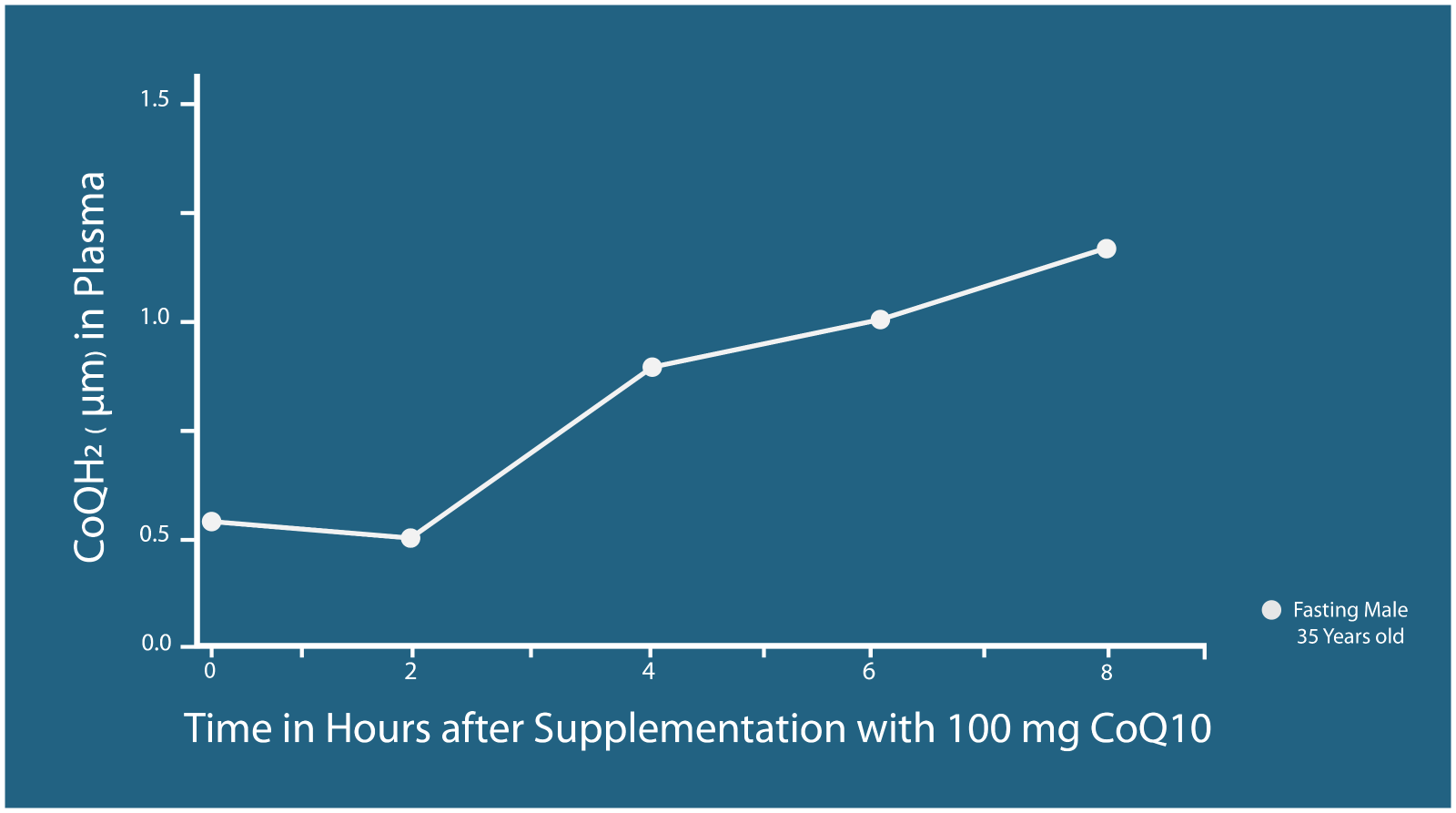
Fig. 10 The Mohr, Bowry, & Stocker study was the first study to show that supplementation with the ubiquinone form of Coenzyme Q10 will significantly increase the plasma and lipoprotein concentration of the antioxidant form ubiquinol. Subsequent studies have confirmed this outcome of ubiquinone supplementation, e.g. Zhang (2018).
Differences in the Way CoQ10 Supplements are Absorbed
In actual fact, there is a difference in the way in which the two forms of Coenzyme Q10 are absorbed. There is some evidence, primarily from large dog studies, that shows that the ubiquinol in ubiquinol supplements is, in fact, absorbed as ubiquinone before being converted back to the ubiquinol form in the lymph (Judy 2015; Judy 2018).
First, though, there are some very important points to be made about the absorption of Coenzyme Q10. One important point is that the CoQ10 raw material comes in a crystalline form, and the human absorption cells cannot absorb CoQ10 crystals. The CoQ10 raw material must be processed in such a way as to make the CoQ10 crystals dissolve to single CoQ10 molecules at body temperature. Only free single molecules of CoQ10 can be absorbed.
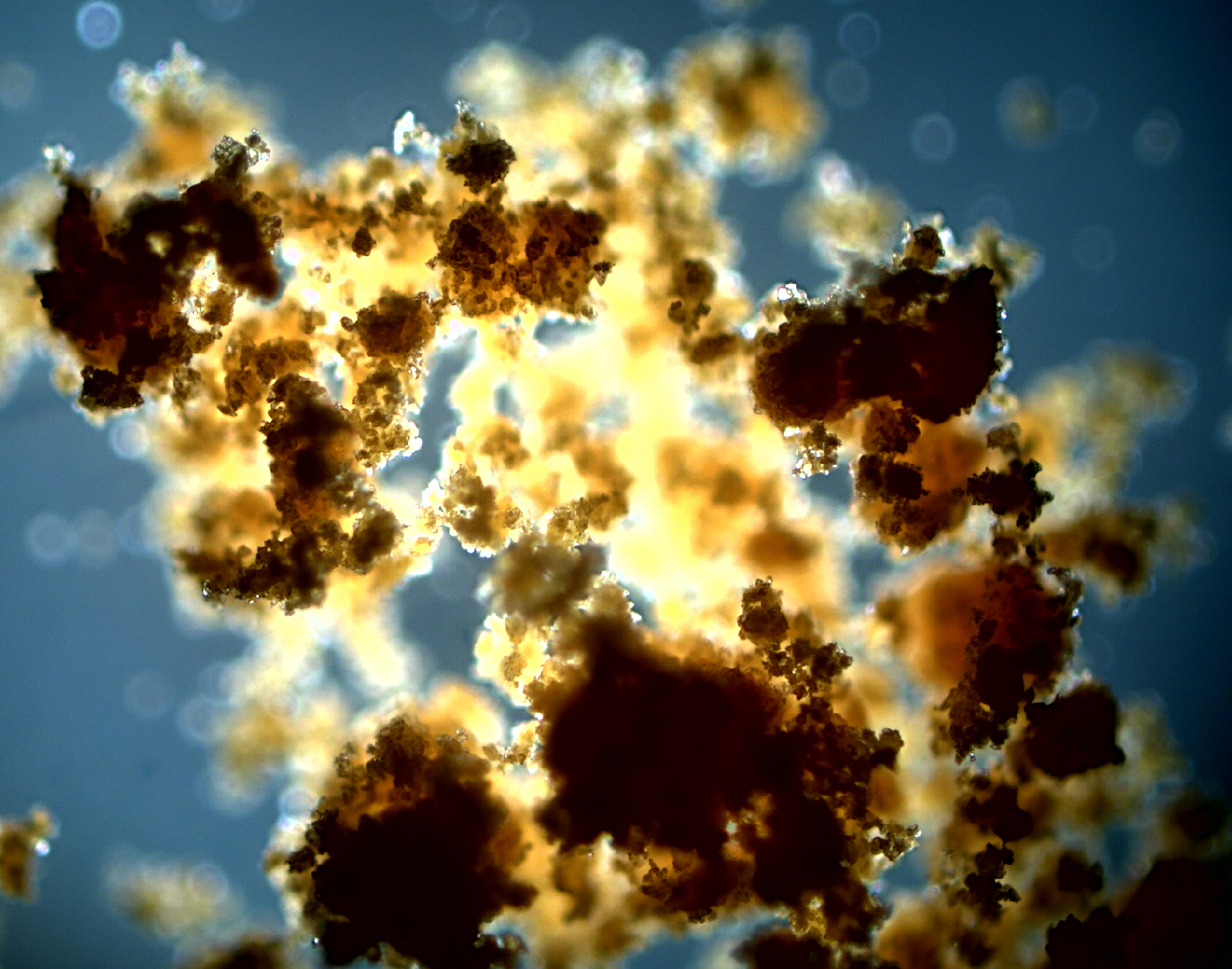 Fig. 11 Lumpy CoQ10 crystals will not dissolve easily at body temperature to single free Coq10 molecules that can be absorbed.
Fig. 11 Lumpy CoQ10 crystals will not dissolve easily at body temperature to single free Coq10 molecules that can be absorbed.
A second important point is that the CoQ10 molecules are fat-soluble molecules, and the environment of the small intestines next to the intestinal absorption cells is a watery environment. The delivery of the fatsoluble CoQ10 molecules depends up on the formation of mixed micelles in the aqueous solution in the small intestines (Shils 2006).
Micelles are necessary to transport fat-soluble substances like Coenzyme Q10 and vitamin E and the various monoglycerides and fatty acids that are found in the chyme following digestion (Judy 2018). The Coenzyme Q10 molecules are too large and too fat-soluble to be absorbed directly from the small intestine into the blood. Instead, they become part of micelles and float through the watery environment of the small intestines in between the microvilli protrusions where the micelles break down and release the Coenzyme Q10 molecules (and other fatty molecules) to be absorbed by the enterocytes.
Oral Ubiquinol Converted to Ubiquinone Prior to Absorption
In the accompanying video, it is assumed that the ubiquinol contents of the capsule are dissolved to single ubiquinol molecules in the stomach. Large animal studies have shown that the contents of the ubiquinol supplement are mostly converted to the ubiquinone form of CoQ10 in the stomach and the duodenum and are then re-converted back to ubiquinol in the lymph. The absorbed Coenzyme Q10 passes into the blood circulation still predominantly in the form of ubiquinol (Judy 2018).
.jpg)
Fig. 12 Dog studies have shown that oral ubiquinol oxidizes and converts to ubiquinone in the stomach and small intestines prior to absorption. Following absorption and transfer into the lymph, the ubiquinone is converted back to ubiquinol. Of course, one must be careful in extrapolating from dog study results to humans.
Coenzyme Q10 Molecules Aggregated into Micelles
The contents of the ingested oral ubiquinol supplement, mostly converted to ubiquinone molecules in the stomach and the duodenum, are exposed to bile salts in the small intestines. Following the conversion of the contents of the ubiquinol capsule to the ubiquinone form of Coenzyme Q10, the contents of the oral ubiquinol supplement will be absorbed in the same way that the contents of a ubiquinone CoQ10 supplement are (Judy 2018).
The bile salts coat the ubiquinone CoQ10 molecules' tails and make them stick together, thus becoming incorporated into micelles (Whitney & Rolfes 1996). The micelles are the somewhat spherical aggregations of lipid molecules in aqueous solutions that transport fat-soluble substances through the aqueous solution to the intestinal absorption cells in the small intestines.
Typically, mixed micelles are formed, combining bile salts and phospholipids and monoglycerides and fatty acids, and, where available, Coenzyme Q10 and vitamin E molecules (Vitetta 2018). In the case of the CoQ10 molecules, the slightly less hydrophobic benzoquinone heads of the CoQ10 molecules are on the outer edge of the micelles, closest to the watery solution in the small intestines, and the very hydrophobic isoprenyl tails of the CoQ10 molecules are tucked away inside the micelles.
.jpg) Fig. 13 Micelles are more or less spherical aggregations of fat-soluble substances like Coenzyme Q10, vitamin E, and fatty acids and monoglycerides that need transport through the watery phase of the small intestine to the enterocytes, the intestinal absorption cells.
Fig. 13 Micelles are more or less spherical aggregations of fat-soluble substances like Coenzyme Q10, vitamin E, and fatty acids and monoglycerides that need transport through the watery phase of the small intestine to the enterocytes, the intestinal absorption cells.
Important to Take Coenzyme Q10 Supplement Together with Some Fat
Thus, the micelles are the body's method of transporting fat-soluble nutrients such as Coenzyme Q10 (and vitamin E) through the watery phase of the small intestines to the intestinal absorption cells (Vitetta 2018). As the micelles come close to the intestinal absorption cells, the micelles break apart and release the CoQ10 molecules into the microvilli, which are the microscopic cellular membrane protrusions of the intestinal absorption cells that offer greater surface area for the absorption of the CoQ10 molecules.
The micelles are so tiny that they cannot be seen without the help of a powerful microscope; the microvilli, on the other hand, can be seen with the naked eye. The tiny micelles can easily slide in between the hair-like microvilli of the individual intestinal absorption cells (Whitney & Rolfes 1996).

Fig. 14 Here, the micelle forms, either as a purely Coenzyme Q10 micelle or as a mixed micelle containing Coenzyme Q10 molecules together with fat-soluble molecules. The micelle transports the Coenzyme Q10 to the microvilli where the micelle breaks up and releases the Coenzyme Q10 molecules to enter the intestinal absorption cells.
Some of the CoQ10 molecules, released from the micelles, can then enter the intestinal absorption cells along with some of the monoglycerides in the chyme in the small intestines. The CoQ10 absorption process itself is a passive facilitated process (Judy 2018). It requires the presence of lipid molecules such as the monoglycerides to act as carrier lipids for the CoQ10 molecules. Consequently, it is very important to take the CoQ10 supplement together with a meal that contains some fat, or, failing that, with a spoonful of peanut butter, for example. The absorption of CoQ10 is much better when it is ingested together with a meal containing some fat or oil (Bhagavan & Chopra 2006; Vitetta 2018).
Two CoQ10 Conversions Necessary When Taking a Ubiquinol Supplement
Note that, in the large dog studies done by Dr. William V. Judy, SIBR Research, (see Fig 11 above), the ubiquinol from the supplement has been converted to the ubiquinone form and is actually absorbed in the ubiquinone form (Judy 2018).

Fig. 15 The ubiquinol capsule contents enter the stomach as 100% ubiquinol assuming that no oxidation has occurred inside the capsule. Already in the stomach and more so in the duodenum, the ubiquinol content begins to convert to the ubiquinone form.
Then, once the ubiquinone has passed from the intestinal absorption cells into the lymph, it converts back to the ubiquinol form. It passes from the lymph to the blood in the form of ubiquinol. Thus, there are two conversions in the body from the time the ubiquinol capsule is swallowed until the Coenzyme Q10 enters the blood circulation (Judy 2018).

Fig. 16 As the contents of the ubiquinol capsule make their way through the small intestine, they are converted almost entirely to the ubiquinone form. Once the Coenzyme Q10 molecules move into the lymph, they are converted back to the ubiquinol form, and, in the ubiquinol form, they enter the blood circulation.
Coenzyme Q10 90-95% Ubiquinol in the Blood Circulation
It is not surprising or alarming that the CoQ10 in the blood circulation is 90-95% in the form of ubiquinol. There is not much need for the bioenergetics form of Coenzyme Q10, the ubiquinone form, in the blood. That need first comes into play when the CoQ10 molecules leave the blood and enter the cells and tissues. In the blood, the great need is for Coenzyme Q10 in the antioxidant form, the ubiquinol form (Judy 2018). The ubiquinol protects against the oxidation of the lipoproteins in the blood.
Only One CoQ10 Conversion Needed for the Absorption of the Ubiquinone Supplement
The ubiquinone supplement, on the other hand, passes from the stomach to the small intestines in the ubiquinone form, and it is absorbed as ubiquinone. It goes into the lymph mostly in the form of ubiquinone, and, then, in the lymph, the reducing agents convert the ubiquinone to ubiquinol. There is but one conversion when CoQ10 is ingested in the form of a ubiquinone supplement (Judy 2018).

Fig. 17 The contents of the ubiquinone capsule, much more stable than the contents of the ubiquinol capsule, enter the stomach and the small intestines in the ubiquinone form and are first converted to the ubiquinol form in the lymph. There is only the one conversion of the contents of a ubiquinone capsule before the Coenzyme Q10 arrives in the blood circulation.
Some in-vitro studies using a Caco-2 intestinal cell model seem to show that ubiquinone molecules are being converted to ubiquinol molecules in the intestinal absorption cells themselves, which is to say prior to moving into the lymph (Craft 2005; Bhagavan 2007). However, large dog studies show the ingested ubiquinone coming from the small intestines mostly as ubiquinone and then being almost totally converted to the ubiquinol form at the point at which the CoQ10 leaves the lymph and enters the blood circulation (Judy 2018).
Comparison Studies of Ubiquinone and Ubiquinol Absorption
Head-to-head comparison studies of the absorption of oral ubiquinone and ubiquinol supplements have been done only in studies with small samples. These studies can be summarized as follows:
The Lopez-Lluch study (2019) showed that the bio-availability of CoQ10 supplements depends more upon the formulation of the supplements and upon the resultant solubilization of the CoQ10 crystals than it does on the form (ubiquinone or ubiquinol) of the supplements. In the Lopez-Lluch study, a patented ubiquinone CoQ10 supplement gave a significantly better bio-availability than a patented ubiquinol supplement did.
.jpg)
Fig. 18 The ubiquinone supplement manufactured with a patented formulation process gave a significantly better bio-availability than did the ubiquinol supplement. The results suggest that the formulation of the Coenzyme Q10 supplement is even more important, in terms of absorption and bio-availability, than the form (ubiquinone vs ubiquinol) is.
Interestingly, in the Lopez-Lluch comparative bio-availability study, the patented ubiquinone supplement significantly outperformed five other ubiquinone Coenzyme Q10 supplements that had different formulations.
.jpg)
Fig. 19 The Lopez-Lluch study demonstrated how important the manufacturer’s choice of the carrier oils in the Coenzyme Q10 supplement’s oil matrix is and how important the heating and cooling process is in the manufacture of a Coenzyme Q10 supplement.
The Zhang study (2018) of two-week supplementation of 10 older men with, alternately, 200 milligrams per day of ubiquinone and ubiquinol showed that both forms increased plasma ubiquinol significantly and that the difference in the increases was not statistically significantly.
The Vitetta study (2018) did not show any statistically significant difference in the increases in plasma ubiquinol concentrations resulting from the ubiquinone and ubiquinol supplement.
The Langsjoen study (2014) shows that ubiquinol supplementation increased total plasma CoQ10 significantly better than ubiquinone CoQ10 supplementation did; however, ubiquinone CoQ10 supplementation did significantly increase plasma CoQ10 levels, and the Mohr, Bowry, & Stocker study (1992) has shown that daily supplementation with the ubiquinone CoQ10 form will significantly increase plasma and lipoprotein ubiquinol concentrations.
The Langsjoen study (2014) showed that both ubiquinone and ubiquinol supplements resulted in 99% ubiquinol levels in plasma. In the Langsjoen study, the same excipients were used in both supplements, so it is likely that the composition of the ubiquinone CoQ10 supplement was a less than optimal composition, i.e. not up to the standard of the ubiquinone CoQ10 supplement tested in the Lopez-Lluch study.
The Evans study (2009) compared the absorption of a powder ubiquinone product with an oil-based soft-gel ubiquinol product. That was an unfair comparison as powder formulations with the powder in tablet form or suspended in oil result in practically no uptake (Bhagavan & Chopra 2006).
The Miles study (2002) did not address the question of statistically significant differences between the ubiquinone supplement and the ubiquinol supplement in the raising of plasma ubiquinol levels.
Transport of CoQ10 to the Blood
The movement of the Coenzyme Q10 molecules through the intestinal absorption cells is not well understood.
In the intestinal absorption cells, the absorbed CoQ10 molecules are packaged into lipoprotein transport vehicles called chylomicrons and released into the lymph (Bhagavan & Chopra 2006). These chylomicrons typically contain triglycerides, cholesterol, phospholipids, and apolipoproteins as well as other fat-soluble dietary components such as Coenzyme Q10, fat-soluble vitamins, and carotenoids (Shils 2006).
The lymph is watery in composition; therefore, the absorbed fat-soluble CoQ10 molecules that come through to the lymph from the intestinal absorption cells need to be bound to lipoproteins (Bhagavan & Chopra 2006). The CoQ10 molecules in the chylomicrons are slowly transported through the lymph to the venous blood. Large dog studies show that the ingested Coenzyme Q10 peaks in the abdominal lymph approximately 2 – 3 hours after ingestion (Judy 2018).
The CoQ10 reaches its peak blood concentration 6 – 8 hours after ingestion. There is often a second smaller peak in the blood CoQ10 concentration about 24 hours after ingestions. This second smaller peak concentration is most likely the result of a return to the blood of some of the absorbed CoQ10 from the liver (Judy 2018).
.jpg)
Fig. 20 A typical graph of Coenzyme Q10 absorption shows a Cmax peak in the blood circulation at 6 – 8 hours and a second lower peak at 24 hours as the Coenzyme Q10 from the liver re-enters the blood (Weis 1994).
Lipoprotein Transport of CoQ10 in the Blood
In the blood plasma, which is also watery in composition, the lipoprotein particles called chylomicrons transport the fat-soluble CoQ10 molecules to the liver. In the liver, the CoQ10 molecules are repackaged mostly into LDL and VLDL lipoproteins, the same lipoproteins that transport cholesterol (Bhagavan & Chopra 2006). Some smaller amount of CoQ10 emerges from the liver bound to HDL lipoproteins. Circulating CoQ10 redistributes among the lipoproteins in the blood, possible for the purpose providing antioxidant protection to the vulnerable lipoproteins (Bhagavan & Chopra 2006).
Thus, the CoQ10 molecules are both highly dependent upon the lipoproteins for transport in the aqueous environment of the plasma and protective of the lipoproteins against oxidative damage (Bhagavan & Chopra 2006).
Studies have shown that CoQ10 supplementation does not adversely affect the body's own synthesis of Coenzyme Q10. Studies in which CoQ10 supplements have been administered and then stopped have shown that the blood CoQ10 concentrations return to the level seen prior to the initiation of the supplementation; the blood CoQ10 concentrations do not fall below previously seen levels as a result of the cessation of supplementation (Bhagavan & Chopra 2006; Ikematsu 2006).
Ubiquinone Supplementation Significantly Increases Ubiquinol Levels in Blood
A much-cited study has shown that daily supplementation with the ubiquinone form of CoQ10 results in significantly increased concentrations of ubiquinol, the antioxidant form of CoQ10, in the blood plasma and in the lipoproteins in the blood (Mohr 1992). In other words, with ubiquinone CoQ10 supplementation, there will be significantly increased resistance of the LDL-lipoproteins to oxidative damage.
.jpg)
Fig. 21 Supplementation with a ubiquinone supplement significantly increases the blood ubiquinol concentration (Mohr 1992)
Documentation of the Effectiveness of Ubiquinone CoQ10 Supplementation
Daily supplementation with 200 milligrams of the patented Bio-Quinone Q10 supplement in combination with daily supplementation with 200 micrograms of the patented SelenoPrecise® organic high-selenium yeast over a period of four years resulted in significantly reduced risk of mortality from heart disease, improved heart function as recorded on echocardiograms, and improved overall health-related quality of life for senior citizens with an average age of 78 years at the beginning of the KiSel-10 study (Alehagen 2013; Johansson 2015).
.png) Fig. 22 The graph shows significantly reduced cardiovascular mortality in the group of senior citizens who took a daily combination of a high-selenium yeast preparation and ubiquinone Coenzyme Q10 capsules for four years (red curve) as compared with the group of senior citizens who took matching placebos (blue curve) (Alehagen 2013).
Fig. 22 The graph shows significantly reduced cardiovascular mortality in the group of senior citizens who took a daily combination of a high-selenium yeast preparation and ubiquinone Coenzyme Q10 capsules for four years (red curve) as compared with the group of senior citizens who took matching placebos (blue curve) (Alehagen 2013).
In the same way, daily supplementation with 300 milligrams of a ubiquinone CoQ10 supplement for two years significantly improved the symptoms and survival of chronic heart failure patients with an average age of 62 years at the start of the study (Mortensen 2014). Moreover, a sub-analysis of the European segment of the Q-Symbio study showed that the ubiquinone CoQ10 supplementation also significantly improved the patients' ejection fraction (Mortensen 2019).
The Q-Symbio Study was the first randomized, double-blind, placebo-controlled study that had a large enough sample (420 heart failure patients), a sufficient dosage of Coenzyme Q10 (3 times 100 milligram per day), and a long enough follow-up period (106 weeks) to test the effectiveness of Coenzyme Q10 adjunctive therapy on major adverse cardiovascular events and mortality in heart failure.
.jpg)
Fig. 23 The Q-Symbio study showed that supplementation with a well-formulated Coenzyme Q10 preparation on top of conventional heart failure medication gives significantly heart health benefits compared to conventional heart failure treatment alone.
Daily supplementation of veterans diagnosed with Gulf War Illness with 100 milligrams of ubiquinone Coenzyme Q10 for 3.5 months significantly improved physical function and symptoms (Golomb 2014).
Ubiquinone CoQ10 Supplement Less Expensive, More Stable, Better Documented
It can be seen that ubiquinone CoQ10 supplements significantly increase the concentration of ubiquinol in the blood. The body will get CoQ10 in the antioxidant form in the lymph and the blood regardless of whether the CoQ10 supplement is in the ubiquinone or ubiquinol form. Ubiquinone CoQ10 supplements with the patented Bio-Quinone Q10 formulation are associated with significant health benefits, also in senior citizens.
These basic facts beg the question: why buy a ubiquinol supplement when a ubiquinone supplement is less expensive, more stable, and better documented?
Why pay more for less?

